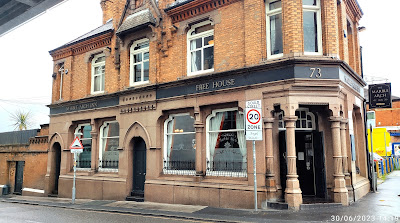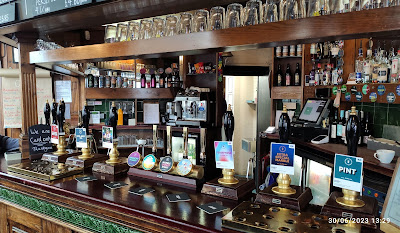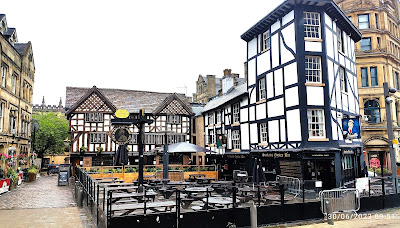Friday's day trip to
Manchester was most enjoyable, and the
perfect day out, where everything worked, even though not always quite as
intended.
My itinerary had been planned around
a
9:20 am arrival in
Manchester, which would allow me time to revisit my old
alma
mater. That isn’t a term I’d normally use, as despite its derivation it’s one
used much more by our
American friends, than it is over here. My
“nurturing mother,” to use the literal translation of this
Latin term, is the
University
of Salford, an institution where I studied at from early
October 1973 through
to late
June 1976.
The
5:00 am start was worth it, and with the sun having only
just risen, when I left the house, combined with the almost told absence our
vehicles, the only sound was that of birdsong. It was nice to be out and about
early for change, although it's not something I want to make a habit of. I walked
down to
Tonbridge station and jumped on the
5:30 am train to
London Bridge. I
was actually booked on the
5:40 departure, but I'm a great believer in getting
to one’s destination earlier should the opportunity arise.
From
London Bridge there are the joys of the
Northern Line, and
whilst the revamped overground station has been a great success, it's now quite
a route march down to the underground, in order to make my cross
London connection
to
Euston. I still arrived in plenty of time, enough to grab some breakfast, as
despite setting my alarm clock early, it wasn’t early enough, not even for a quick
bowl of cereal, before leaving home.
Unfortunately, my choice of
“food to go” wasn't a good one,
as the
"Ultimate Breakfast Roll" from
Upper Crust, failed to deliver, certainly
in terms of taste. Grilled bacon, and sliced sausage, topped with a fried egg slapped
in a bun and then re- heated in a powerful microwave, seemed like a good enough
bet, but whilst the end result was filling, it was totally lacking in taste,
and the only saving grace was the cup of flat white coffee.
There is an outdoor space in front of the station, complete
with fixed, sturdy, wipe down tables and benches. It is adjacent to where the
new
HS2 Terminal is supposedly being built. I say supposedly, as a strapped for
cash,
UK Government, has put the new station building on hold for the next two
years, and possibly longer, leaving an unsightly hole in the ground. This
abandonment must seem particularly galling to all the businesses whose
premises were purchased (and demolished), to make way for the new station, and
the uncertainty surrounding yet more dithering by a government that has run out
of ideas, continues to affect affecting the lives of local residents and
business owners alike.
My train was shown as running on time, and as soon as the
departure platform was announced I made my way down slope and boarded the
7:13 am
Avanti West Coast service to
Manchester Piccadilly. The train was comfortable,
clean, and above all fast, the journey taking a mere two hours and 8 minutes, with
just three stops on the way (
Nuneaton, Stoke on Trent, and
Stockport).
Avanti
have come in for a lot of criticism since taking over the
West coast mainline
franchise from
Virgin Rail, but on this occasion, everything worked like clockwork
(the same applied on the return journey as well), and on a dull an overcast
morning, plagued by intermittent drizzle, I walked out of
Piccadilly station
for the first time in nearly
50 years, and headed into the heart of
Manchester.
My plan was to catch a train to
Salford Crescent station, opposite
the university, but my research wasn’t sufficiently thorough, as it was only
after buying my ticket at
Manchester Victoria, that I discovered I could have
travelled there from
Piccadilly. It didn't really matter, because the walk through
the city’s main shopping areas, allowed me to experience central
Manchester up
close, for the first time, in nearly half a century. Considerably more of the centre
has been pedestrianised than I remember, but the most striking thing was the
Arndale Centre, completely rebuilt after the devastating
IRA bomb of 1996, that devastated a wide area of central Manchester, including
the hideous looking
Arndale Centre.
Work on the centre was well underway by the time I arrived
in Manchester, and towards the end of my time in the city, the
Arndale Centre
opened to much fanfare. Like many locals, I was not alone in thinking that the
Arndale, with its exterior of hideous yellow tiles, assembled a public toilet!
It’s probably too harsh a comment to make, given the people injured by the
blast, the businesses destroyed and the huge cost of rebuilding the city
centre, but from an aesthetic and practical point of view, the
Provisional IRA
did
Manchester a favour, which wasn’t just confined to the removal of those
awful, yellow tiles.
Walking towards
Victoria station, the thing that struck me
most is the reconstructed centre looks outward, with shops along many of the
streets bordered by the centre. In the
1970s original, the majority of retail
outlets were inward looking and could only be accessed from inside the
Arndale
itself. So, despite the destruction, the injuries, and the enormous cost of the
rebuild,
Manchester at last appears to have a shopping centre it can be proud
of.
The
University of Salford was also much changed, as I
discovered after exiting
Salford Crescent station, and walking the short
distance to my former seat of learning.
Salford Uni was a very young
institution back in the
1970s, and whilst plans had been drawn up to expand the
university, (including a model of what the place would look like in the
future), these had obviously changed during the intervening years. Fortunately,
there are still a number of buildings in existence today, that I recognised
from my time there.
These included the grand and ornate P
eel Building, constructed
in
1896, as
Salford’s Technology Institute and College, which was the origin of
today’s university. Its attractive, red brick and sculpted terracotta façade looks
out across a lawn towards another building I recognised, and it was there that I
headed to first. Known as the
Maxwell Building, this
1960’s construction overlooks
the neighbouring
Peel Park, as well as the
River Irwell. I entered and after
telling the lady at reception that I was a former student asked if it was OK for
me to have a wander around the site. She told me that would be fine, and although
term had finished for the academic year, some of the buildings were still open,
and I could take a look inside them, should I wish.
I thanked her and
headed off for a nostalgia tour around the site. On the way I stopped for a look
inside the red-brick, Salford Museum & Art Gallery, an institution which
housed paintings from the city's most famous, and best-known artist, the
painter LS Lowry. The art gallery in particular, had provided a welcome refuge
from academia, so I was looking forward to seeing some of Lowry’s work. I of
course, should have realised that the paintings have now, all been rehoused in the
purpose built, Lowry Centre, at Salford Quays.
Fortunately, one memorable painting I remember from my
student days was still on display, and it had the same impression on me, as it
did nearly
50 years ago. It is by the English painter,
John Charles Dollman,
and is titled,
“Famine." The photo above, probably doesn’t do it justice, but
with its vision of a shrouded
“death” surrounded by a pack of starving wolves,
set against the backdrop of a bleak and frozen landscape, it’s enough send
shivers down anyone’s spine!
Time was getting on, so after a quick tour of the rest of
the
Peel Park Campus, where the only building I recognised was
University House – home
then, and now of the
Students Union. This was a space where both students,
staff and academics could relax, enjoy a drink, in one of two bars, or a meal in
the ground floor restaurant. With term time over, it wasn’t very busy, so I made
my way back to the station, ready to head back into
central Manchester. On the
way I received a
WhatsApp message, from pub-ticker extraordinaire,
Retired Martin, saying he would meet me at
Sinclair’s Oyster House, close to
Manchester
Cathedral.
The message wasn’t completely out of the blue, as we had provisionally
arranged to meet up, depending on
Martin’s other commitments, so it was a nice surprise to hear from him, frustrated only by my having just missed a train and then
finding the following one cancelled. I shall continue the narrative in the next
post, as it details the four
city centre pubs we visited together, as well as
the two I called into on my own.



















































